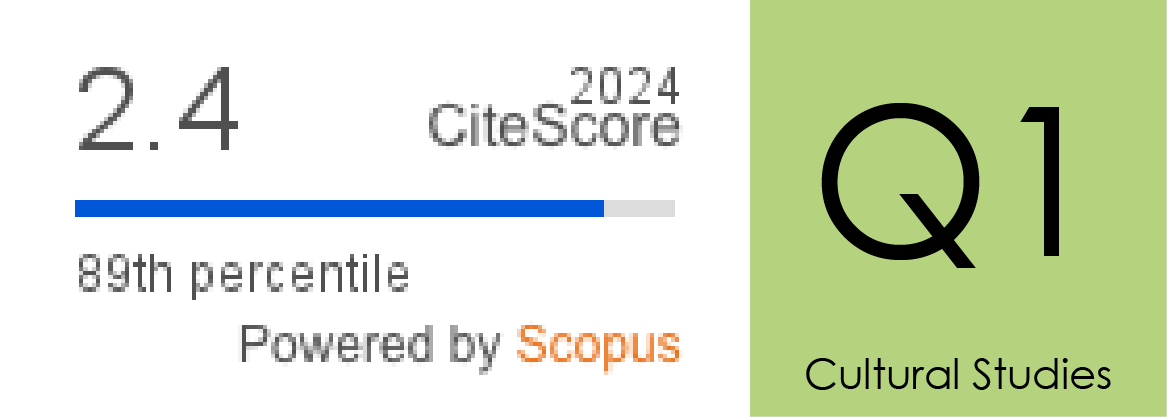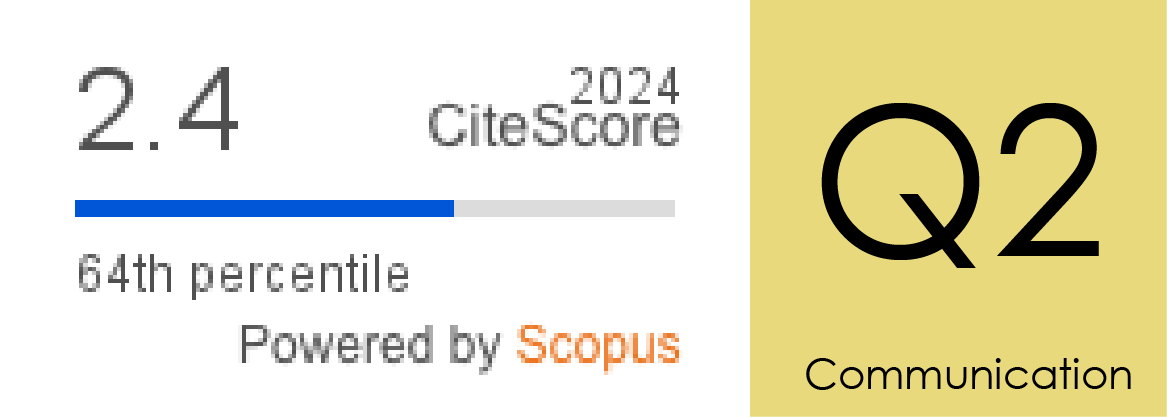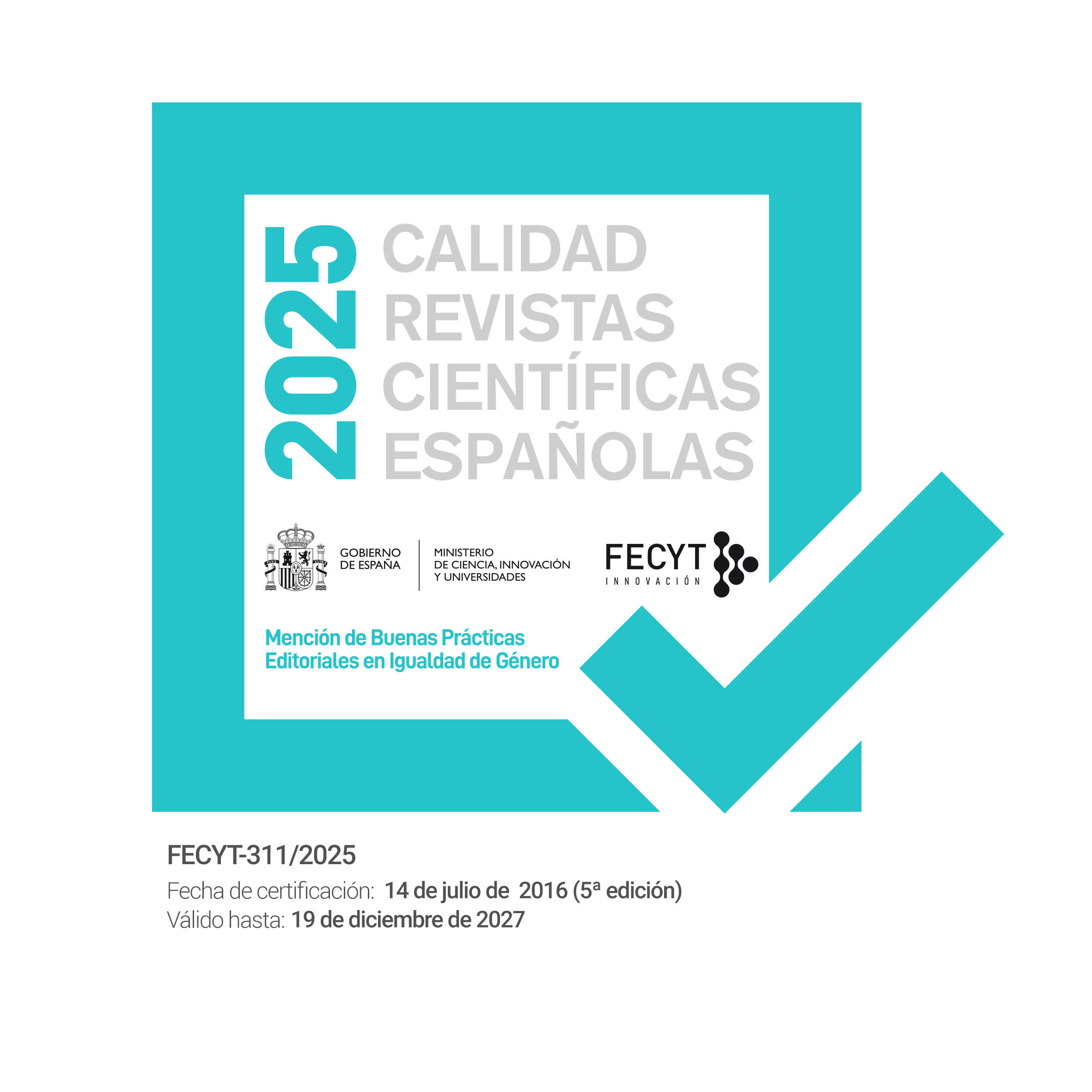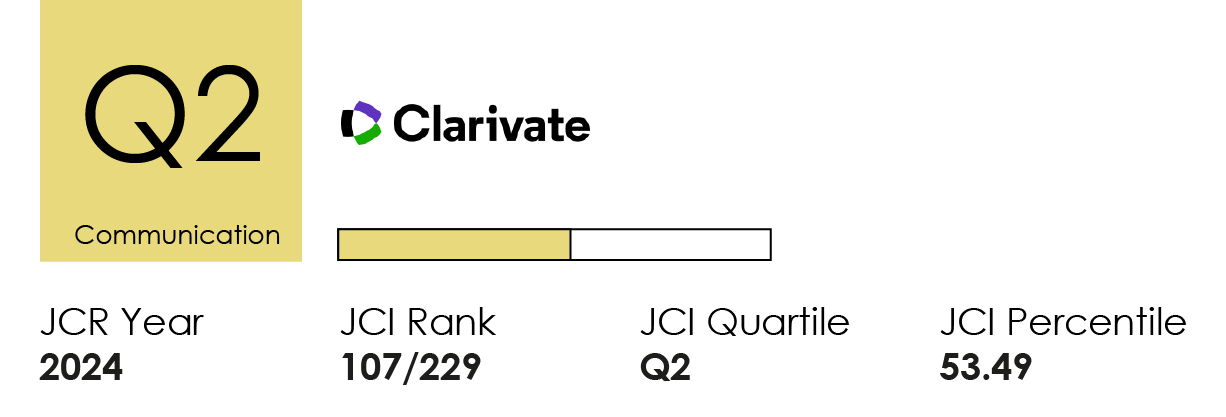Credibilidad de los medios: un análisis bivariado de las opiniones de los españoles
DOI:
https://doi.org/10.14198/MEDCOM2012.3.06Palabras clave:
Medios, Credibilidad, Prensa, Radio, Televisión, InternetResumen
La credibilidad es un tema central en el debate sobre los medios. Sus implicaciones sobre la calidad de los medios y su posible asociación con los comportamientos de las personas en el consumo de noticias justifican su estudio. Este artículo examina la opinión de los españoles sobre cuál es medio con mayor credibilidad. Se explora su asociación con el género, edad, nivel de estudios, medio preferido para informarse, nivel de exposición a las noticias, nivel de diversidad de la dieta mediática-informativa y patrón de consumo habitual de noticias de los encuestados. Se analizan datos de una encuesta suministrada en 2010 a una muestra representativa (n= 1.205) de la población española. Los resultados esclarecen que, para la mayoría de los españoles, la televisión es el medio más creíble. Sin embargo, los resultados varían según las características individuales de las personas estudiadas. La opinión sobre cuál es el medio más creíble está asociada principalmente al nivel de estudios. Las personas con mayor formación creen que el medio con mayor credibilidad es la prensa. La asociación con el patrón de consumo habitual de noticias y el medio preferido para informarse sugieren que los encuestados atribuyen más credibilidad a los medios que consumen habitualmente, por tanto, la credibilidad relativa refleja en mayor medida el grado de afectividad por un medio que un juicio comparativo sobre la veracidad de los contenidos.
Citas
AIMC (Asociación para la Investigación de los Medios de Comunicación) (2011): Marco General de los Medios en España 2011. Madrid: AIMC.
American Society of Newspaper Editors (1985): Newspaper credibility: Building readers trust. Washington, DC: MORI Research Inc.
Austin, E. W. y Dong, Q. (1994): “Source v. content effects on judgments of news believability”. Journalism Quarterly , nº 71, pp. 973-983.
Berg, K., y Keifer, M. (2006): Massenkommunikation VII. Eine Langzeitstudie zur Mediennutzung und Medienbewertung 1964-2005. Baden-Baden: Nomos.
Bucy, E. (2003): “Media credibility reconsidered: synergy effects between on-air and online news”. Journalism and Mass Communication Quarterly, nº 80 (2), pp. 247.
Carter, R. F., & Greenberg, B. S. (1965): “Newspapers or television: Which do you believe?”. Journalism Quarterly , nº42, pp. 29-34.
Choi, J., Watt, J., y Lynch, M. (2006): “Perceptions of News credibility about the war in Iraq: Why war opponents perceived the Internet as the most credible medium”. Journal of Computer-mediated Communication , nº 12, pp. 209.
Col·legi de Periodistes de Catalunya (2004): Llibre blanc de la professió periodística a Catalunya. Barcelona: Generalitat de Catalunya.
Col·legi de Periodistes de Catalunya (2006): Libre blanc de la professió periodística a Catalunya. Barcelona: Generalitat de Catalunya.
Diezhandino, M. P. (2007): Periodismo y poder. Madrid: Prentice-Hall.
Farias Batlle, Pedro (dir.) et al. (2005): Informe Anual de la Profesión Periodística 2005. Madrid: Asociación de la Prensa de Madrid.
Farias Batlle, Pedro (dir.) et al. (2006): Informe Anual de la Profesión Periodística 2006. Madrid: Asociación de la Prensa de Madrid.
Farias Batlle, Pedro (dir.) et al. (2007): Informe Anual de la Profesión Periodística 2007. Madrid: Asociación de la Prensa de Madrid.
Farias Batlle, Pedro (dir.) et al. (2008): Informe Anual de la Profesión Periodística 2008. Madrid: Asociación de la Prensa de Madrid.
Farias Batlle, Pedro (dir.) et al. (2009): Informe Anual de la Profesión Periodística 2009. Madrid: Asociación de la Prensa de Madrid.
Farias Batlle, Pedro (dir.) et al. (2010): Informe Anual de la Profesión Periodística 2010. Madrid: Asociación de la Prensa de Madrid.
Farias Batlle, P. y Roses, S. (2008): “Informe sobre la credibilidad de los medios”, en Farias Batlle, Pedro (dir.) et al.: Informe Anual de la Profesión Periodística 2008. Madrid: Asociación de la Prensa de Madrid, pp. 111-132.
Flanagin, A. J., & Metzger, M. J. (2000): “Perceptions of Internet information credibility”. Journalism & Mass Communication Quarterly , nº 77, pp. 515-540.
Gaziano, C., & McGrath, K. (1986): “Measuring the concept of credibility”. Journalism Quarterly, nº 63, pp. 451-462.
Greenberg, B. S. (1966): “Media use and believability: Some multiple correlates”. Journalism Quarterly, nº43, pp. 655- 670.
Gunther, A. (1992): “Biased Press or Biased Public? Attitudes Toward Media Coverage of Social Groups”. The Public Opinion Quarterly, nº 56, pp. 147-67.
Ibelema, M., & Powell, L. (2001): “Cable television news as most credible”. Newspaper Research Journal , nº 22, pp. 41.
IG-INVESTIGA. (2008): “Los jóvenes, el sector que más credibilidad otorga a Internet como Medio de comunicación”, Asociación Nacional de Empresas de Internet, 23 de 7 de 2009, http://www.a-nei.org/noticias/los-jonenes-el-sector-que-mas-credibilidad-otorga-a-internetcomo-medio-de-comunicacion.html
Jacobson, H. (1969): “Mass Media Believabiliy: A study of receiver judments”. Journalism Quarterly, nº 46, pp. 20-28.
Johnson, T. J., & Kaye, B. K. (1998): “Cruising is believing? Comparing internet and tradicional sources on media credibility measures”. Journalism & Mass Communication Quarterly, nº 75, pp.325-340.
Johnson, T. J., & Kaye, B. K. (2000): “Using us believing: The influence of reliance on the credibility of online political information among politically interested Internet users”. Journalism & Mass Communication Quarterly, nº 77 (4), pp. 865-879.
Johnson, T. J., & Kaye, B. K. (2002): “Webelievability: a path model examining how convenience and reliance predict online credibility”. Journalism & Mass Communication Quarterly, nº79 (2), pp. 619-642.
Johnson, T. J., & Kaye, B. K. (2004): “Wag the blog: How reliance on tradicional media and the Internet influence credibility perceptions of weblogs among blog users”. Journalism & Mass Communication Quarterly, nº 81 (3), pp.622-642.
Johnson, T. J., & Kaye, B., Bichard, S., & Wong, W. (2007): “Every Blog has its day: politically-interested internet users perceptions of blog credibility”. Journal of ComputerMediated Communication, nº13 (1), pp. 100-122.
Kim, D., & Johnson, T. J. (2009): “A shift in media credibility: comparing Internet and Tradicional News sources in South Korea”. International Communication Gazette, nº 71 (4), pp. 283-302.
Kiousis, S. (2001): “Public trust or mistrust? Perceptions of media credibility in the information age”. Mass Communication & Society, nº 4, pp. 381-403.
Lee, R. S. (1978): “Credibility of Newspaper and TV News”. Journalism Quarterly, nº55 (2), pp.282-287.
Lo, V. H., Lin, W. C., Niu, L. G., & Tsai, C. F. (2003): “Media reliance, media use, and election news credibility”. Mass Communication Research , nº 74, pp.19-44.
Lu, H., & Andrews, J. E. (2006): “College Students' perception of the absolute media credibility about SARS Related news during the SARS Outbreak in Taiwan”. China Media Research, nº 2 (2), pp. 85-93.
Luo, W., & Chen, S. (1993): The study on the news media credibility. The Report of National Science Council Research Project. National Science Council Research Project.
Mehrabi, D., Hassan, M. A., & Ali, S. M. (2009): “News Media Credibility of the Internet and Television”. European Journal of Social Sciences, nº11, pp. 136-148
Metzger, M. J., Flanagin, A. J., Eyal, K., Lemus, D., & McCann, R. (2003): “Credibility for the 21st century: Integrating perspectives on source, message, and media credibility in the contemporary media environment”, en Kalfleisch, P. J. (Ed.): Communication yearbook. NJ: Lawrence Erlbaum, Vol. 27, pp. 293-335.
Meyen, M., & Schwer, K. (2007): “Credibility of media offering in centrally controlled media systems: a qualitative study bases on the example of East Germany”. Media, Culture & Society ,nº 29, pp. 284-303.
Mulder, R. (1980): “Media credibility: A uses and gratifications approach”. Journalism Quarterly, 474-476.
Mulder, R. (1981): “A log-linear analysis of media credibility”. Journalism Quarterly, nº58, pp. 635.
Newhagen, J., & Nass, C. (1989): “Differential Criteria for Evaluating Credibility of Newspaper and TV News”. Journalism Quarterly , nº 66 (2), pp. 277-284.
Park, C. (2005): “Decomposing Korean news media credibility in the internet age”. International Journal of Public Opinion Research, nº 18 (2), pp. 238.
Rimmer, T., & Weaver, D. (1987): “Different Questions, Different Answers? Media Use and Media Credibility”. Journalism Quarterly, nº 64 (1), pp. 28-36
Robinson, M. J., & Kohut, A. (1988): “Believability and the Press”. Public Opinion Quarterly, nº 52, pp. 174.
Roper, B. W. (1985): Public attitudes toward television and other media in a time of change. New York: The Television Information Office.
Roper, B. W. (1977): Changing public attitudes toward television and other mass media 1959-1976. New York: Television Information Office.
Roses, Sergio (2010): Aproximación a la confianza de la ciudadanía en la institución mediática: El caso de España a través de datos cuantitativos (2006-2009). Tesis doctoral inédita. Universidad de Málaga.
Schweiger, W. (2000): “Media credibility-experience or image? A survey on the credibility of the World Wide Web in Germany in comparision to other media”. European Journal of Communication, nº 15, pp. 37-59.
Shaw, E. (1973): “Media credibility: Taking the measure of a measure”. Journalism Quaarterly , nº 50, pp. 306-311.
Slater, M. D., & Rouner, D. (1996): “How message evaluation and source attributes may influence credibility assessment and belief change”. Journalism Quarterly , nº 73, pp. 974-991.
Sundar, S. (1998): “Effect of source attribution on perception of online stories”. Journalism & Mass Communication Quarterly , nº 75 (1), pp. 55-68.
Sundar, S. (1999): “Exploring receivers' criteria for perception of print and online news”. Journalism & Mass Communication Quarterly, nº 76 (2), pp. 373-386.
The Pew Research Center for the People and the Press. (12 de 9 de 2009). Public evaluations of the News Media: 1985-2009. Press accuracy rating hits two decade low. Recuperado el 1 de 3 de 2012, de The Pew Research Center for the People and the Press: HTTP://www.people-press.org
Tichenor I, P.; Donohue, G. Y Olien, C. (1970): “Mass media flow and differential growth in knowledge”. Public Opinion Quarterly, nº 34, pp. 159-170.
Tichenor I, P.; Donohue, G. Y Olien, C. (1980): Community Conflict and the Press, Sage, Newbury Park, Cal.
Tseng, S., & Fogg, B. J. (1999): “Credibility and computing technology”. Communications of the ACM , nº 42 (5), 39-44.
Wanta, W., & Hu, Y. (1994): “The effects of credibility, reliance and exposure on media agenda-setting: A path analysis model”. Journalism Quarterly, nº 71, pp. 90-98.
Westley, B. H., & Severin, W. (1964): “Some correlates of media credibility”. Journalism Quarterly , nº 51, pp. 325-335.
Zhang, M. (2006): “The present situation and analysis of Mass media use & media credibility in countriside of midChina: the case of Hubei Province”. China Media Research , nº2 (4), pp. 37.
Descargas
Estadísticas
Publicado
Cómo citar
Número
Sección
Licencia
Derechos de autor 2012 Sergio Roses, Pedro Farias-Battle

Esta obra está bajo una licencia internacional Creative Commons Atribución-CompartirIgual 4.0.
Los autores y autoras que publican en esta revista están de acuerdo con los siguientes términos:
1 Derechos de autor. Los autores y autoras conservan sus derechos de autor, aunque ceden a la revista de forma no exclusiva los derechos de explotación (reproducción, distribución, comunicación pública y transformación) y garantizan a esta el derecho de primera publicación de su trabajo, el cual estará simultáneamente sujeto a la licencia indicada en punto 2. Los autores pueden establecer otros acuerdos adicionales para la distribución no exclusiva de la versión de la obra publicada en la revista, siempre que exista un reconocimiento de su publicación inicial en esta revista.
© Los autores.
2 Licencia. Los trabajos se publican en la revista sujetos a la licencia de Reconocimiento 4.0 Internacional de Creative Commons (CC BY 4.0); los términos se pueden consultar en https://creativecommons.org/licenses/by/4.0/
Esta licencia permite a terceros compartir (copiar y redistribuir el material en cualquier medio o formato) y adaptar (remezclar, transformar y crear a partir del material para cualquier finalidad, incluso comercial), siempre que se reconozca la autoría y la primera publicación en esta revista (Revista Mediterránea de Comunicación (RMC) / Mediterranean Journal of Communication (MJC), Universidad de Alicante, DOI de la obra), se proporcione un enlace a la licencia y se indique si se han realizado cambios en la obra.
3 Política de autoarchivo. Se recomienda a los autores que difundan sus trabajos a través de Internet para favorecer una circulación y difusión más rápidas y, con ello, un posible aumento en la citación y alcance entre la comunidad científica y académica, en las siguientes condiciones:
No se permite a los autores depositar en un repositorio institucional o temático, página web propia, etc., las versiones preprint (versión antes de ser evaluada) o postprint (versión evaluada y aceptada para su publicación) de sus trabajos antes de su publicación, pero sí el artículo final publicado (versión del editor).













